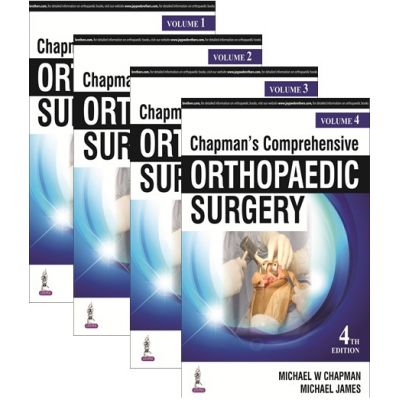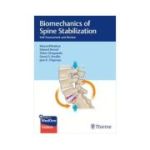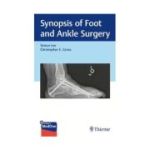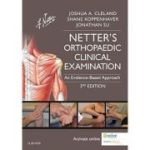Chapman's Comprehensive Orthopaedic Surgery

DESCRIERE
Chapman’s Comprehensive Orthopaedic Surgery is the latest edition of this vast reference guide, spanning four volumes. This book is edited by internationally renowned experts in orthopaedic surgery from the University of California Davis Medical Centre.
Divided into 311 chapters across thirteen sections, the book covers all aspects of both conservative and operative treatment – from pre-operative planning to surgical procedures and post-operative rehabilitation. The book begins with a section on the basic science of the musculoskeletal system, followed by diagnosis of musculoskeletal disorders, and each subsequent section provides step by step instruction for relevant surgical procedures. The final section of the book covers rehabilitation including treatment techniques management of specific diagnoses such as motor neurone disease, cerebral palsy and spina bifida.
Chapman’s Comprehensive Orthopaedic Surgery is an indispensable resource for orthopaedic surgeons and residents, with contributions from over 900 experts from across the globe and enhanced by 7250 full colour images. The full text, with images and videos demonstrating surgical techniques, is made available online with the purchase of the physical copy of the book.
Key Points
- New edition of this extensive reference guide to orthopaedic surgery
- Previous edition published in 2000 (9780781714877)
- Edited by internationally renowned experts in orthopaedic surgery from the University of California Davis Medical Centre
- Over 900 contributors from across the globe
- 7250 full colour images across four volumes
- Full text with images and videos demonstrating surgical techniques available online with purchase of print version
Section 1: Basic Science of the Musculoskeletal System
-
Development and Morphogenesis of Skeletal Tissues
-
Bone Formation and Resorption: Osteoblasts and Osteoclasts
-
Joint Formation: Articular Cartilage and Meniscus
-
Tendon and Ligament Biology and Biomechanics
-
Intervertebral Disc: Biology and Pathophysiology
-
Extracelluar Matrix: Collagens and Proteoglycans
-
Fibronectin, Integrins and Cell Adhesion
-
Injury, Repair and Regeneration of Skeletal Tissues
-
Tissue Engineering of Skeletal Tissues
-
Biomechanics and Biology of Skeletal Tissues
-
Tissue Banking and Allografts for Tissue Repair
-
Bone Morphogenetic Proteins and Other Morphogens
-
Skeletal Muscle Development and Physiology
-
Nerve Development and Physiology
-
Cellular, Molecular and Genetic Basis of Tissue Function
-
Kinesiology
-
Biomemetic Biomaterials and Nanomaterials
-
Stem Cells for Regenerative Medicine
Section 2: Diagnosis and Workup of Musculoskeletal Disorders
-
History of Orthopaedic Surgery
-
Physical Examination of the Musculoskeletal System
-
Imaging of the Musculoskeletal System including Ultrasound.
-
Laboratory Workup of Musculoskeletal Diseases
-
Thromboembolic Disease and Pulmonary Embolism
-
Professionalism in Surgery
-
Surgical Approaches: Hand, Wrist and Forearm
-
Surgical Approaches: Shoulder, Arm and Elbow
-
Surgical Approaches: Spine
-
Surgical Approaches: Acetabulum and Pelvis
-
Surgical Approaches: Lower Extremity
-
Preoperative Planning and Perioperative Management
-
Anaesthesia and Pain Management
-
Soft Tissue Management
-
Instrumentation and Implants
-
Bone Grafting, Bone Graft Substitutes, and Growth Factors
Section 3: Fractures, Dislocations, Non-unions and Mal-unions in Adults Subsection: 3a. General
-
Principles of Closed Treatment of Fractures and Dislocations
-
Principles of Internal and External Fixation
-
Treatment Principles for Open Fractures
-
Management of the Multiply Injuried Patient
-
Diagnosis and Management of Compartment Syndromes Subsection: 3b. Upper Extremity
-
Fractures of the Scapula Including the Glenoid
-
Fractures of the Clavicle
-
Fractures and Fracture/Dislocations of the Proximal Humerus
-
Fractures of the Humeral Shaft
-
Fractures of the Distal Humerus
-
Fractures and Dislocations about the Elbow
-
Fractures of the Forearm
-
Fractures of the Distal Radius Subsection: 3c. Pelvis and Femur
-
Pelvic Ring Injuries
-
Fractures of the Acetabulum
-
Hip Dislocations and Femoral Head Fractures
-
Hip Fractures in the Elderly
-
Femoral Head Fracures in the Young Adult
-
Atypical Fractures of the Proximal Femur
-
Fractures of the Proximal Femur and Diaphysis of the Femur
-
Distal Femur Fractures
Subsection: 3d. Knee, Tibia and Ankle, and Foot
-
Fractures of the Patella
-
Fractures of the Tibial Plateau
-
Fractures of the Shafts of the Tibia and Fibula
-
Ankle Fractures: Operative Treatment and Syndesmosis Injury
-
Ankle Fractures: Ankle Arthroscopy and Fracture Treatment
-
Pilon Fractures
-
Talus Fractures and Dislocations
-
Calcaneus Fractures
-
Midfoot Fractures and Dislocations
-
Metatarsal and Phalanx Fractures
Subsection3e: Nonunion and Malunions
-
Principles of Treatment of Nonunions and Malunions
-
Nonunions and Malunions of the Upper Extremity
-
Nonunions and Malunions of the Pelvis
-
Nonunions and Malunions of the Hip
-
Nonunions and Malunions of the Femur and Patella
-
Nonunions and Malunions of the Tibia
-
Ilizarov Techniques for Nonunions, Malunions and Leg Length Discrepancy
Section 4: Injuries of the Hand, Wrist and Forearm Including Microsurgery and Peripheral Nerve injuries
Subsection: 4a. Microvascular Surgery
-
Principles of Microvascular Surgery
-
Vascular Disorders in the Upper Extremity
-
Replantation
-
Free Tissue Transfer
-
Vascularized Bone Grafts
Subsection: 4b. Trauma
-
Fingertip and Nailbed Injuries
-
Dislocations and Ligamentous Injuries of the Digits
-
Fractures of the Metacarpals and Phalanges
-
Dislocations of the Carpus
-
Carpal Fractures
-
Injuries of the Distal Radioulnar Joint
-
Gunshot, Crush, Injection and Frostbite Injuries of the Hand
-
Amputations of the Hand
Subsection: 4c. Conditions of Tendons
-
Principles of Tendon Repair
-
Flexor Tendon Injuries
-
Extensor Tendon Injuries
-
Stenosing Tenosynovitis
-
Lateral and Medial Elbow Tendinopathy
Subsection: 4d. Conditions of Nerves
-
Principles of Nerve Repair and Nerve Transfers
-
Compression Neuropathies of the Upper Extremity
-
Neuromas
-
Principles of Restoration of Muscle Balance after Forearm and Hand Paralysis
-
Radial Nerve Palsy
-
Median Nerve Palsy
-
Ulnar Nerve Palsy
-
Brachial Plexus Injuries
-
Brachial Plexus Birth Palsy
-
Thoracic Outlet Disorders
Subsection: 4e. Reconstructive Procedures
-
Dupuytren’s Disease
-
Intrinsic Muscle Contractures
-
Hand Burns
-
Volkman’s Contracture
-
Dysfunction of the Upper Extremity Following Stroke or Brain injury
-
The Upper Extremity in Tetraplegia
-
Congenital Hand Malformations: Part I
-
Congenital Hand Malformations: Part II
-
Arthroplasty of the Hand
-
Basilar Thumb Arthritis
-
Arthrodesis of the Hand and Wrist
-
Infections of the Hand
-
Tumors of the Hand
-
Arthroscopic Surgery of the Wrist
Section 5: The Shoulder and Elbow in Adults Subsection: 5a. Shoulder
-
Shoulder Anatomy and Biomechanics
-
Shoulder Arthritis
-
The Rotator Cuff Deficient Shoulder
-
Shoulder Arthroplasty for Proximal Humeral Trauma
-
Failed Shoulder Arthroplasty
-
Shoulder Stiffness
-
Scapular Disorders Subsection: 5b. Elbow
-
Elbow Anatomy and Biomechanics
-
Arthroplasty and Arthrodesis of the Elbow
-
Elbow Arthroplasty for Fractures
-
Failed Arthroplasty of the Elbow
-
Stiffness of the Elbow
Section 6. Sports injuries and Arthroscopy Subsection: 6a. General
-
Principles of Sports Medicine and the Role of the Team Physician
-
Stress Fractures
-
Adolescent Sports Injuries
Subsection: 6b. Shoulder
-
Arthroscopy of the Shoulder: Set-up and Basic Principles
-
Throwing Injuries of the Shoulder or Shoulder Injuries in the Throwing Athlete: SLAP lesions,
LHB, GIRD, Internal Impingement, and Suprascapular Nerve Compression
-
Injuries of the Acromioclaviclular and Sternoclavicular Joints
-
Shoulder Instabilities
-
Rotator Cuff Disorders
-
Other Shoulder Conditions
Subsection: 6c. Elbow
-
Tendon Disorders of the Elbow
-
Arthroscopy of the Elbow
-
Elbow Instabilities
Subsection: 6d. Hip
-
Arthroscopy of the Hip
-
Tendon Injuries Around the Hip Subsection: 6e. Knee
-
Anatomy and Biomechanics of the Knee
-
Principles of Knee Arthroscopy
-
Synovial Disorders
-
Arthroscopic Meniscectomy and Repair
-
Meniscal Transplantation
-
Chrondral Injuries and use of Biologics
-
Extensor Tendon Injuries of the Knee
-
Anterior Cruciate Ligament Injuries
-
Isolated Posterior Cruciate Ligament Injuries
-
Multiple Ligament Injuries of the Knee (Knee Dislocations)
-
Patellofemoral Disorders
-
Posterolateral Instability of the Knee
-
Management of Complications of Knee Surgery Subsection: 6f. Foot and Ankle
-
Special Considerations in Sports Injuries of the Foot and Ankle
-
Ligament Injuries of the Foot and Ankle
-
Ligament Injuries of the Foot and Ankle
-
Ligament Injuries of the Foot and Ankle: Medial Instability
-
Ligament Injuries of the Foot and Ankle: Midfoot/Lisfranc Injuries
-
Ligament Injuries of the Foot and Ankle: Forefoot/Turf Toe Injuries
-
Tendon Injury: Achilles: Acute
-
Tendon Injury: Achilles: Chronic
-
Tendon Injury: Peroneal Tendon
-
Tendon Injury: Peroneal Tendon FHL, PTT, TA, EHL
-
Tendon Injury: Other Tendon: FHL, PTT, TA, EHL
-
Common Sports Fractures in the Foot: Jones Fractures
-
Common Sports Fractures in the Foot: Stress Fractures
-
Ankle Arthroscopy: Basics, History and Techniques
-
Ankle Arthroscopy: Ankle Impingement
-
Ankle Arthroscopy: Talus OCD
-
Ankle Arthroscopy: Subtalar Arthroscopy
-
Ankle arthroscopy: 1st MTP Arthroscopy
-
Ankle arthroscopy: Hindfoot Arthroscopy
Section 7: Reconstruction and Arthroplasty of the Hip and Knee
Design and Performance of Joint Replacements
-
Osteotomies about the Hip including Periacetabular Osteotomies
-
Primary Hip Arthroplasty including Hemi-arthroplasty and Total Hip Athroplasty
-
Primary Hip Arthroplasty: Anterior Hip Arthroplasty
-
Failed Hip Arthroplasty: Revision and Arthrodesis
-
Osteotomies about the Knee
-
Primary Total Knee Arthroplasty
-
Failed Knee Arthroplasty: Revision and Arthrodesis
-
Management of Periprosthetic Infection
Section 8: The Foot and Ankle
Subsection: 8a. Arthritis of the Foot and Ankle
-
Ankle Arthritis: Epidemiology, Gait Changes, and Non-operative Treatment
-
Ankle Arthritis: Ankle Preservation Techniques
-
Ankle Arthritis: Arthrodesis
-
Ankle Arthritis: Total Ankle Arthroplasty
-
Outcomes of TAA And Treatment Of Painful TAA
-
Subtalar Arthritis
-
Hindfoot and Pantalar Arthrodesis
-
Midfoot Arthritis
-
Hallux Rigidus: Introduction & Non-operative Care
-
Hallux Rigidus: Chielectomy, Osteotomy, Hemiarthroplasty, Interposition Arthroplasty
-
Hallux Rigidus: 1st MTP Arthrodesis
Subsection: 8b. Adult Acquired Flatfoot Disorder
-
Adult Acquired Flatfoot Deformity
-
Flexible Flatfoot Reconstruction
-
Triple Arthrodesis for the Rigid Flatfoot Deformity
Subsection: 8c. Hallux Valgus
-
Hallux Valgus
-
Surgical/Operative Treatment of Hallux Valgus Subsection: 8d. Lesser Toe Pathology
-
Hammer Toes
-
Metatarsalgia and Plantar Plate Pathology Subsection: 8e. Inflammatory and Rheumatologic Disorders
-
Arthropathy and Rheumatologic Considerations in F&A Surgery
-
Operative Treatment of F&A Inflammatory Disease Subsection: 8f. Diabetic Disorders of the Foot and Ankle
-
Diabetic Disorders of the Foot and Ankle: General Principles
-
Diabetic Infections
-
Charcot Disease and Treatment
Subsection: 8g. Neurological Disorders of the Foot and Ankle
-
Causes and Treatment of Footdrop
-
Tarsal Tunnel Syndrome
-
Peripheral Nerve Lesions Including Morton's Neuroma
-
Neuromuscular Disorders and Cavus Deformity
Subsection: 8h. Miscellaneous Disorders of the Foot and Ankle
-
Nail Disorders
-
Skin Disorders
Section 9: Musculoskeletal Oncology and Amputations
A. Principles of Limb Salvage Surgery B. Tumors of the Shoulder Girdle
C. Tumors of the Hip and Pelvis
D. Tumors of the Knee
-
Bone and Soft Tissue Imaging
-
Benign Bone Tumors
-
Malignant Bone Tumors
-
Benign Soft Tissue Tumors
-
Malignant Soft Tissue Tumors
-
Marrow Cell Tumors and Metastatic Disease to Bone
-
Amputations of the Upper Extremity
-
Amputations of the Lower Extremity
Section 10: Infectious, Metabolic, Neurological and Other Musculoskeletal Disorders
-
Principles of Treatment of Infection and Antimicrobial Therapy
-
Management of Acute and Chronic Osteomyelitis
-
Management of Septic Arthritis
-
Metabolic Bone Disease
-
Management of Synovial Disease
-
Heterotopic Ossification and Charcot Arthropathy
-
Osteonecrosis
-
Orthopaedic Management of Lower Extremity Dysfunction Following Stroke or Brain Injury
Section 11: Spine
Subsection: 11a. Principles and Anatomy
-
History of Spine Surgery
-
Use of Bone Grafting, Bone Graft Substitutes, and Growth Factors in Spine
-
Use of Spinal Orthoses
-
Radiologic Imaging of the Spine
-
Cervical Surgical Approaches
-
Thoracic and Lumbar Surgical Approaches
-
Biomechanics of Spinal Instrumentation
Subsection: 11b. Trauma
-
Fractures and Instability of Occ-C-1-C-2
-
Fractures and Dislocations of the Cervical Spine from C-3 to C-7
-
Thoracolumbar Fractures: Evaluation, Classification and Initial Treatment
-
Operative Treatment of Thoracic and Thoracolumbar Fractures
-
Fractures of the Sacrum
Subsection: 11c. Disc Injury and Degenerative Disease
-
Pathophysiology of Degenerative Disc Disease
-
Non-operative Management of Cervical and Lumbar Degenerative Diseases
-
Surgical Management of Cervical Degenerative Diseases
-
Surgical Management of Lumbar Disc Disease
-
Management of Failed Surgery for Lumbar Degenerative Disorders
Subsection: 11d. Tumors and Infections of the Spine
-
Pyogenic Infections of the Spine
-
Granulomatous Infections of the Spine
-
Primary Tumors of the Spine
-
Metastatic Tumors of the Spine
Subsection: 11e. Rheumatologic Disease of the Spine
-
Rheumatological Disorders Affecting the Spine
-
Surgical Treatment of Rheumatoid Arthritis of the Cervical Spine
-
Surgical Treatment of Ankylosing Spondylitis
Subsection: 11f. Spinal Deformity
-
Principles of Treatment and Non-operative Care of Scoliosis
-
Surgery for the Growing Spine
-
Surgery for Pediatric Idiopathic Scoliosis
-
Spinal Surgery in Congenital Spine Deformity
-
Surgery for Pediatric Kyphotic Deformity
-
Surgery for Pediatric Spondylolisthesis
-
Surgical Treatment of Myelomeningocele
-
Surgical Treatment of Neuromuscular Deformites
-
Surgical Treatment of Adult Scoliosis
-
Surgical Treatment of Degenerative Scoliosis
-
Surgical Treatment of Sagittal Plane Deformities in Adults
-
Revision and Salvage of Failed Surgery for Spinal Deformity
Section 12: Pediatric Disorders
-
Growth and Development of the Musculoskeletal System
-
Role of Genetics in Pediatric Orthopaedics
-
Pediatric Musculoskeletal Examination
-
Normal Gait and Assessment of Gait Disorders
-
Endocrine and Metabolic Disorders
-
Skeletal Dysplasias and Syndromes
-
Musculoskeletal Trauma in Children
-
Musculoskeletal Infections in Children
-
Lower Extremity Disorders in Children
-
Hip Disorders in Children: Developmental Dysplasia of the Hip
-
Hip Disorders in Children: Legg-Calve-Perthes Disease
-
Hip Disorders in Children: Slipped Capital Femoral Epiphysis
-
Hip Disorders in Children: Impingement
-
Knee Disorders in Children
-
Foot Disorders in Children
-
Neuro-orthopaedics: Cerebral Palsy, Nonambulatory
-
Neuro-orthopaedics: Cerebral Palsy, Ambulatory
-
Neuro-orthopaedics: Cerebral Palsy, Upper Extremity
-
Neuro-orthopaedics: Myelodysplasia
-
Neuro-orthopaedics: Poliomyelitis
-
Limb Deficiency in Children
Section 13: Rehabilitation and Physical MedicineSubsection: 13a. Evaluation
-
Physiatric History and Physical Examination
-
Electrodiagnosis
-
Nerve Conduction Studies
-
Intraoperative Monitoring
-
Musculoskeletal Ultrasound
-
Impairment Rating and Disability Determination Subsection: 13b. Treatment Techniques and Modalities
-
Physical Modalities and Electrical Stimulation
-
Therapeutic Exercise
-
Manipulation, Massage and Traction
-
Upper Extremity Orthotics
-
Lower Extremity Orthotics
-
Upper Extremity Prosthetics
-
Lower Extremity Prosthetics
-
Wheelchairs, Seating Systems, and Mobility Aids
-
Peripheral Joint and Soft Tissue Injection Techniques
-
Spinal Injection Techniques
-
Spasticity Management
-
Integrative Medicine Approach to Chronic Musculoskeletal Pain
Subsection: 13c. Rehabilitation of Specific Diagnoses
-
Peripheral Neuropathy
-
Myopathy
-
Motor Neuron Disease
-
Concussion and Traumatic Brain Injury
-
Spinal Cord Injury
-
Cerebral Palsy
-
Spina Bifida
-
Amputation Rehabilitation
-
Burns
-
Osteoarthritis and Rheumatologic Disorders
Categorii de carte
-Comandă specială
-Edituri
-Promo
-Publicaţii Callisto
-Cărţi noi
-- 2551,50 leiPRP: 2835,00 lei
- 3024,00 leiPRP: 3360,00 lei
- 2956,80 leiPRP: 3360,00 lei
Promoţii
-- 170,10 leiPRP: 378,00 lei
- 2551,50 leiPRP: 2835,00 lei
- 3024,00 leiPRP: 3360,00 lei













REVIEW-URI